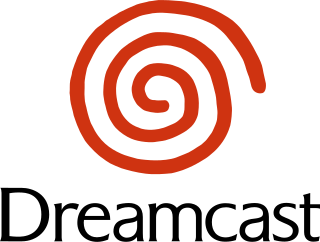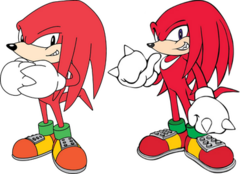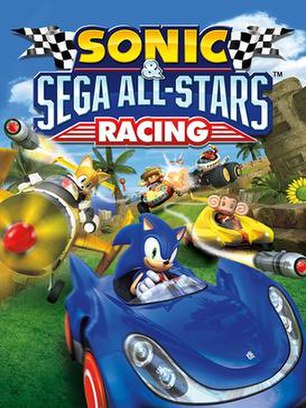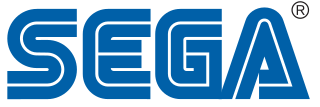Sonic Team, currently Sega CS Research and Development #2 (CS2), is a Japanese video game development division of Sega. Sonic Team is best known for the long-running Sonic the Hedgehog series and games such as Nights into Dreams and Phantasy Star Online.

The Game Gear is an 8-bit fourth generation handheld game console released by Sega on October 6, 1990 in Japan, in April 1991 throughout North America and Europe, and during 1992 in Australia. The Game Gear primarily competed with Nintendo's Game Boy, the Atari Lynx, and NEC's TurboExpress. It shares much of its hardware with the Master System, and can play Master System games by the use of an adapter. Sega positioned the Game Gear, which had a full-color backlit screen with a landscape format, as a technologically superior handheld to the Game Boy.

The 32X is an add-on for the Sega Genesis video game console. Codenamed "Project Mars", the 32X was designed to expand the power of the Genesis and serve as a transitional console into the 32-bit era until the release of the Sega Saturn. Independent of the Genesis, the 32X uses its own ROM cartridges and has its own library of games. The add-on was distributed under the name Super 32X in Japan, Genesis 32X in North America, Mega Drive 32X in the PAL region, and Mega 32X in Brazil.

The Sega CD, released as the Mega-CD in most regions outside North America and Brazil, is a CD-ROM accessory for the Sega Genesis video game console designed and produced by Sega as part of the fourth generation of video game consoles. It was released on December 12, 1991 in Japan, October 15, 1992 in North America, and 1993 in Europe. The Sega CD lets the user play CD-based games and adds hardware functionality such as a faster central processing unit and graphic enhancements. It can also play audio CDs and CD+G discs.

The Sega Saturn is a 32-bit fifth-generation home video game console developed by Sega and released on November 22, 1994 in Japan, May 11, 1995 in North America, and July 8, 1995 in Europe. The successor to the successful Sega Genesis, the Saturn has a dual-CPU architecture and eight processors. Its games are in CD-ROM format, and its game library contains several arcade ports as well as original games.

The Dreamcast is a home video game console released by Sega on November 27, 1998 in Japan, September 9, 1999 in North America, and October 14, 1999 in Europe. It was the first in the sixth generation of video game consoles, preceding Sony's PlayStation 2, Nintendo's GameCube and Microsoft's Xbox. The Dreamcast was Sega's final home console, marking the end of the company's 18 years in the console market.

Sonic the Hedgehog is the title character and protagonist of the Sonic the Hedgehog video game series released by Sega, as well as numerous spin-off comics, animations, and other media.

The Sega Master System (SMS) is a third-generation home video game console manufactured by Sega. It was originally a remodeled export version of the Sega Mark III, the third iteration of the SG-1000 series of consoles, which was released in Japan in 1985 and featured enhanced graphical capabilities over its predecessors. The Master System launched in North America in 1986, followed by Europe in 1987, and Brazil in 1989. A Japanese version of the Master System was also launched in 1987, which has additional features over the Mark III and other regional variants of the console, namely a built-in FM audio chip, a rapid-fire switch and a dedicated port for the 3D glasses. A cost-reduced model known as the Master System II was released in 1990 in North America and Europe.

Knuckles the Echidna is a fictional character in Sega's Sonic the Hedgehog series. He is a red anthropomorphic echidna who is determined and serious, but sometimes gullible. He has the ability to glide and climb up walls, and is a powerful fighter due to his spiked hands. He serves as the guardian of the Master Emerald, a huge gemstone that controls the series' integral Chaos Emeralds.

The SG-1000 is a home video game console manufactured by Sega and released in Japan, Australia, and other regions. It was Sega's first entry into the home video game hardware business. Introduced in 1983, the SG-1000 was released on the same day that Nintendo released the Family Computer in Japan. The SG-1000 was released in several forms, including the SC-3000 computer and the redesigned SG-1000 II released in 1984. A third iteration of the console, the Sega Mark III, was released in 1985, which provided a custom video display processor over previous iterations and served as the basis for the Master System in 1986, Sega's first internationally-released console.
Sega Sammy Holdings Inc. is a Japanese consolidated holding company & conglomerate formed from the merger of Sega and Sammy in 2004. Both companies are involved in the amusement industry.

Gunstar Heroes is a run and gun video game developed by Treasure and published by Sega. It was Treasure's debut game, originally released on the Mega Drive in 1993. The game's premise is centered around a pair of characters, the Gunstars, in their efforts to stop an evil empire from recovering four powerful gems. The characters can fire guns and perform a series of acrobatic maneuvers to fight enemies across each stage. There are four weapons in the game which can be combined with one another to create different shot types.

The Sega Genesis, known as the Mega Drive in regions outside of North America, is a 16-bit home video game console developed and sold by Sega. The Genesis was Sega's third console and the successor to the Master System. Sega released the console as the Mega Drive in Japan in 1988, followed by North America as the Genesis in 1989. In 1990, the console was distributed as the Mega Drive by Virgin Mastertronic in Europe, Ozisoft in Australasia, and Tec Toy in Brazil. In South Korea, the systems were distributed by Samsung as the Super Gam*Boy and later the Super Aladdin Boy.

Sonic the Hedgehog is a video game franchise produced by Sega centering on a series of high-speed platform games. Sonic, the protagonist, is an anthropomorphic blue hedgehog with supersonic speed. Typically, Sonic must stop antagonist Doctor Eggman's plans for world domination, often helped by his friends, such as Tails, Amy, and Knuckles.

Sonic & Sega All-Stars Racing is a kart racing video game, part of the Sega Superstars series, produced for Wii, Xbox 360, PlayStation 3, Nintendo DS, and Microsoft Windows, featuring characters from Sega franchises. A mobile version has been developed by Gameloft. The game was released for iOS in June 2011, as a paid download. A version for OS X was released by Feral Interactive in April 2013.

The history of Sega, a Japanese multinational video game developer and publisher, spans from 1960 to the present day, with roots back to Standard Games in 1940 and Service Games of Japan in the 1950s. The formation of the company is traced back to the founding of Nihon Goraku Bussan, which became known as Sega Enterprises, Ltd. following acquisition of Rosen Enterprises. Sega began developing coin-operated games in 1966 with Periscope. In 1969 Gulf and Western Industries bought Sega, which continued its successful arcade-game business.















